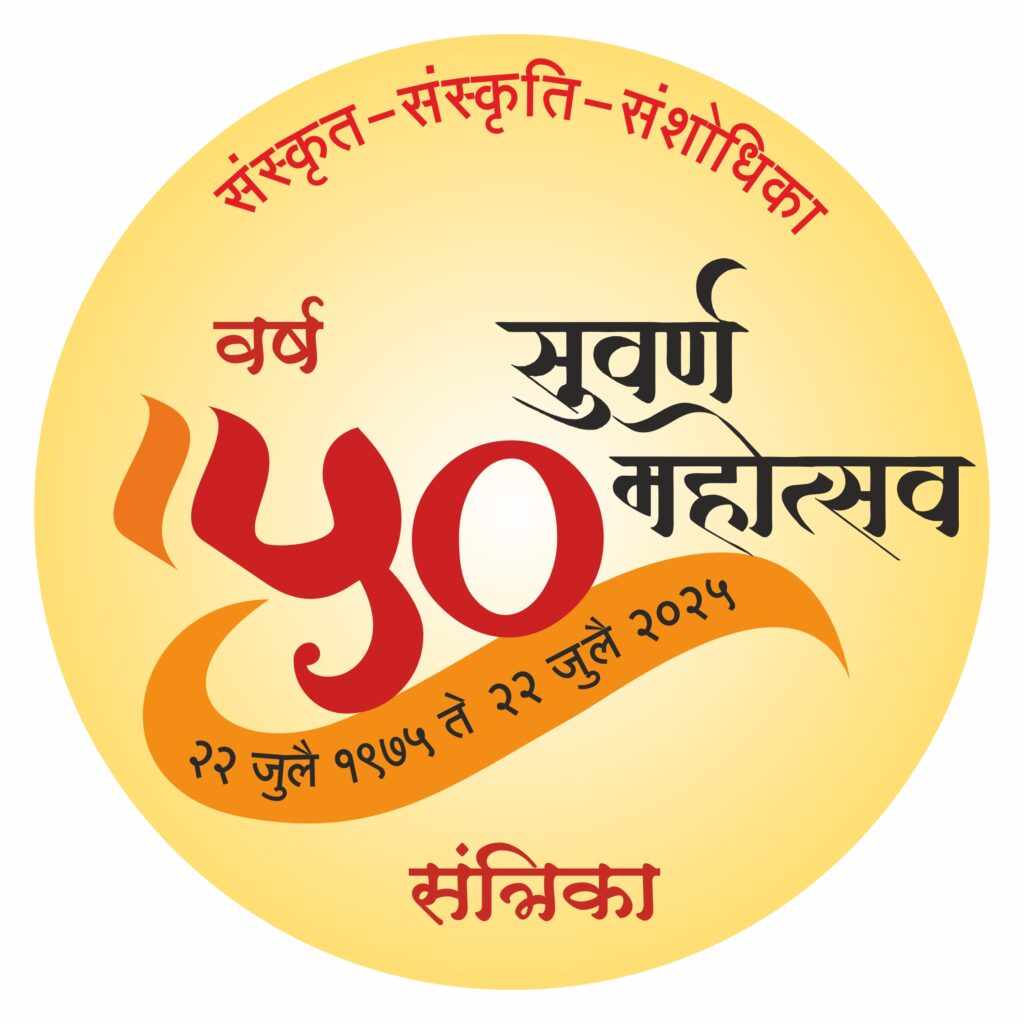लेख क्र. १

ज्ञान प्रबोधिनीच्या संस्कृत-संस्कृति-संशोधिका (संत्रिका) या विभागाच्या कामाची सुरुवात १९७५ साली प्रा. कृष्ण. श्री. अर्जुनवाडकर, जे संस्कृतचे गाढे अभ्यासक होते व प्रबोधिनीशी सुरुवातीपासून जोडले गेले होते, त्यांच्याकडे सोपविण्यात आली होती. काम सुरु झाल्यानंतर साधारण ४ वर्षांनंतर झालेल्या कामाबद्दल व भावी काळात संत्रिकेकडून अपेक्षित कामाबद्दल त्यांनी ज्ञान प्रबोधिनी, खंड २ मध्ये इंग्रजी भाषेत विस्तृत लेख लिहिला आहे. संत्रिका विभागाच्या सुवर्ण-महोत्सवानिमित्त तो लेख क्रमशः येथे पुनर्प्रकाशित करीत आहोत.
Birth and After
On July 22, 1975, Jnana Prabodhini (JP), gave birth to a new babe, later named Sanskrit-Sanskriti-Sanshodhika, or briefly ‘SANTRIKA’ (alluding to the presence of three-trika-Sans in its full form), meaning Sanskrit and Cultural Research Institute. In the presence and with the blessings of about a dozen Sanskritists in Pune, the institute was commissioned forth-with to devise means and programmes for the study, preservation and development of Sanskrit and Indian Culture, both at the popular and the research levels. The task of nursing the new babe and taking its care through the various stages of growth was assigned to Prof. K. S. Arjunwadkar, associated with the JP since its foundation.
Sanskrit language, literature and the culture reflected in them have, to all serious-minded and knowledgeable people, a two-fold value: a world value, and a national value. To the world, Sanskrit as a language, belonging to the Indo-European family, is of basic importance, has a long and rich tradition of literature, and commands a unique position as an indisputable, reliable means of understanding the life, mind and culture of the ancient man. The very theory of Indo-European Family of languages owes its origin to the discovery and a deep study of Sanskrit by the European Scholarship and was first heralded by Sir William Jones-popularly known as “ORIENTAL JONES ” in his oft-quoted observation, made in 1786 before the Royal Asiatic Society of Calcutta, about the more-than-accidental relationship between Sanskrit and European languages. The tremendous contribution this theory has made to anthropology cannot be better expressed than by the observation of Prof. Max Muller who considered as the greatest discovery of the 18th century the linguistic equation that Sanskrit ‘Dyaus-pitar’ = Greek ‘Zeus Pater’ = Latin ‘Jupiter’. And all is not said when this anthropological importance of Sanskrit is stressed. Traditions of linguistics, philosophy, literary criticism, Yoga and the like in Sanskrit still continue to inspire and influence world thought in these areas. The impact of Sanskrit Culture, centuries after centuries, on countries East and West of India is too well-known to be detailed. Thus ‘Sanskrit’ by its origin and its basic character links us to the West. But it has been no less potent a bond of union, for India with the lands of Asia with Serindia or Central Asia of ancient and mediaeval times where the cultures of China and India had a common meeting place; with Tibet, China and the lands within the orbit of Chinese Civilization – Korea and Japan and Vietnam and above all, with the lands of farther east of India-Burma and Siam, Pathet Land and Cambodia, and Cochin-China or Champa, and the area of Malaya and Indonesia. Ceylon is of course a historical and cultural projection of India (Report of the Government of India Sanskrit Commission, Pg. 74-75.) All these factors contributed to Sanskrit being recognized as a subject of international importance and it occupies a place of honor in the curricula of leading Universities all over the world.
During the period of a little over four years now, the SANTRIKA has made a steady but sure progress on the basis of which it now stands recognized by the Central as well as the State Governments, and is looking forward to University recognition as a Post-graduate Research Centre. It is also gaining a place of love, admiration and respect in the hearts of the lovers of Sanskrit and Culture.
Why a New Institute?
“In a city like Pune, already crowded with institutions devoted to Sanskrit, many of them on the point of starvation because of the sharp decline in the number of students offering Sanskrit studies, what is the propriety of starting a new institute for a similar purpose?” was amongst the foremost questions asked when SANTRIKA made its first appearance on the stage. Was not the same question asked when its parent institute, the JP, was founded? And are not there still quite a few who, for different reasons, doubt that the JP was ever or is now doing something basically essential to the well-being and progress of the society? The JP has answered such questions fairly well by its work and results during an unbelievably short span of time; and the SANTRIKA, alive to the JP heritage, can hope to do the same. Since, however, the conception of an institute anticipates, the lines and dimensions of the development thereof, an outline of the purpose and the guidelines of the SANTRIKA may not be out of place here.
World Value of Sanskrit
Sanskrit language, literature and the culture reflected in them have, to all serious-minded and knowledgeable people, a two-fold value: a world value, and a national value. To the world, Sanskrit as a language, belonging to the Indo-European family, is of basic importance, has a long and rich tradition of literature, and commands a unique position as an indisputable, reliable means of understanding the life, mind and culture of the ancient man. The very theory of Indo-European Family of languages owes its origin to the discovery and a deep study of Sanskrit by the European Scholarship and was first heralded by Sir William Jones-popularly known as “ORIENTAL JONES “-in his oft-quoted observation, made in 1786 before the Royal Asiatic Society of Calcutta, about the more-than-accidental relationship between Sanskrit and European languages. The tremendous contribution this theory has made to anthropology cannot be better expressed than by the observation of Prof. Max Muller who considered as the greatest discovery of the 18th century the linguistic equation that Sanskrit ‘Dyaus’- pitar’ = Greek ‘Zeus Pater’ = Latin ‘Jupiter’. And all is not said when this anthropological importance of Sanskrit is stressed. Traditions of linguistics, philosophy, literary criticism, Yoga and the like in Sanskrit still continue to inspire and influence world thought in these areas. The impact of Sanskrit Culture, centuries after centuries, on countries East and West of India is too well-known to be detailed. Thus ‘Sanskrit’ by its origin and its basic character links us to the West. But it has been no less potent a bond of union, for India with the lands of Asia with Serindia or Central Asia of ancient and mediaeval times where the cultures of China and India had a common meeting place; with Tibet, China and the lands within the orbit of Chinese Civilization – Korea and Japan and Vietnam and above all, with the lands of farther east of India-Burma and Siam, Pathet Land and Cambodia, and Cochin-China or Champa, and the area of Malaya and Indonesia. Ceylon is of course a historical and cultural projection of India (Report of the Government of India Sanskrit Commission, Pg. 74-75.) All these factors contributed to Sanskrit being recognized as a subject of international importance and it occupies a place of honor in the curricula of leading Universities all over the world.
क्रमशः
